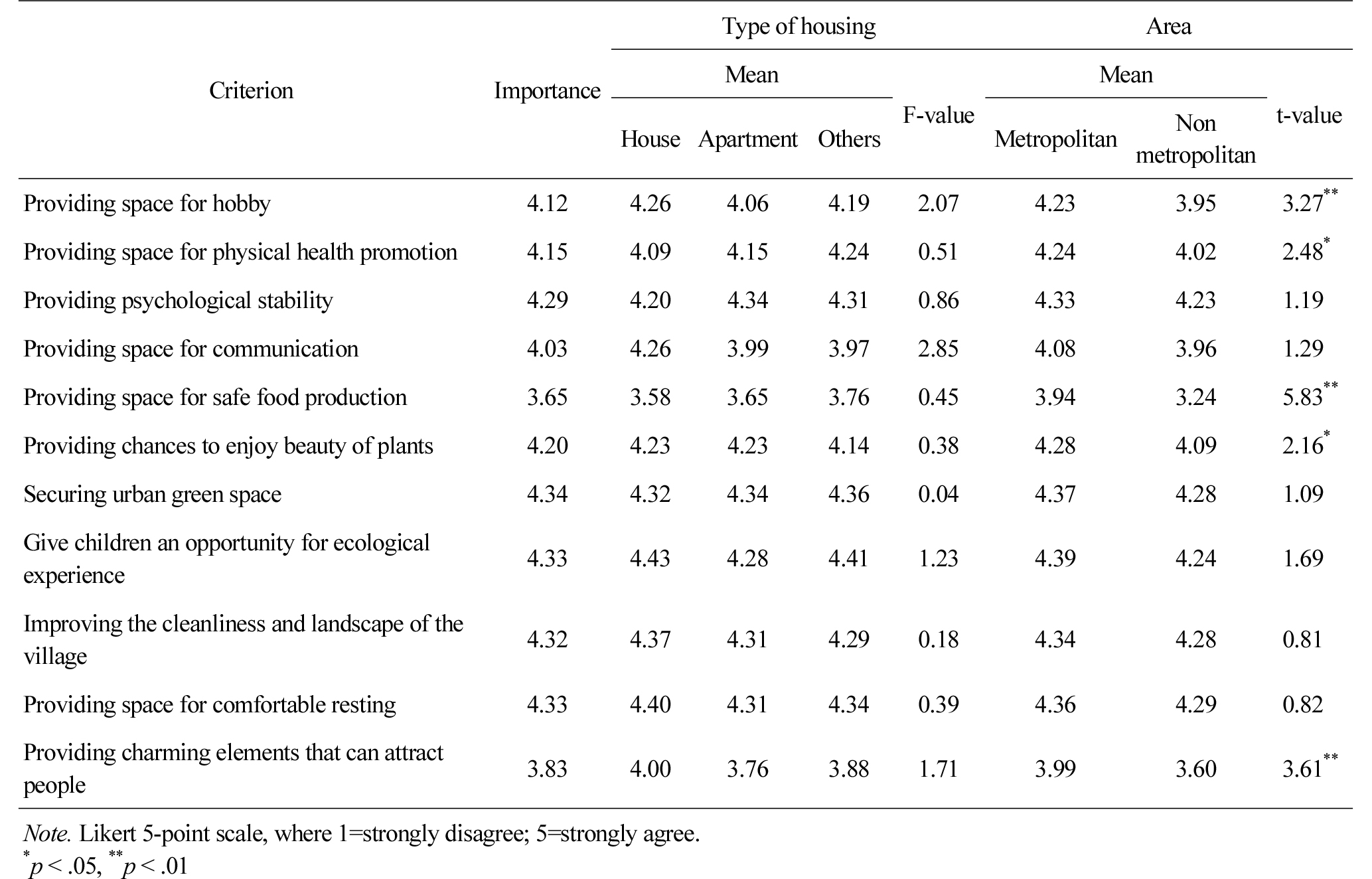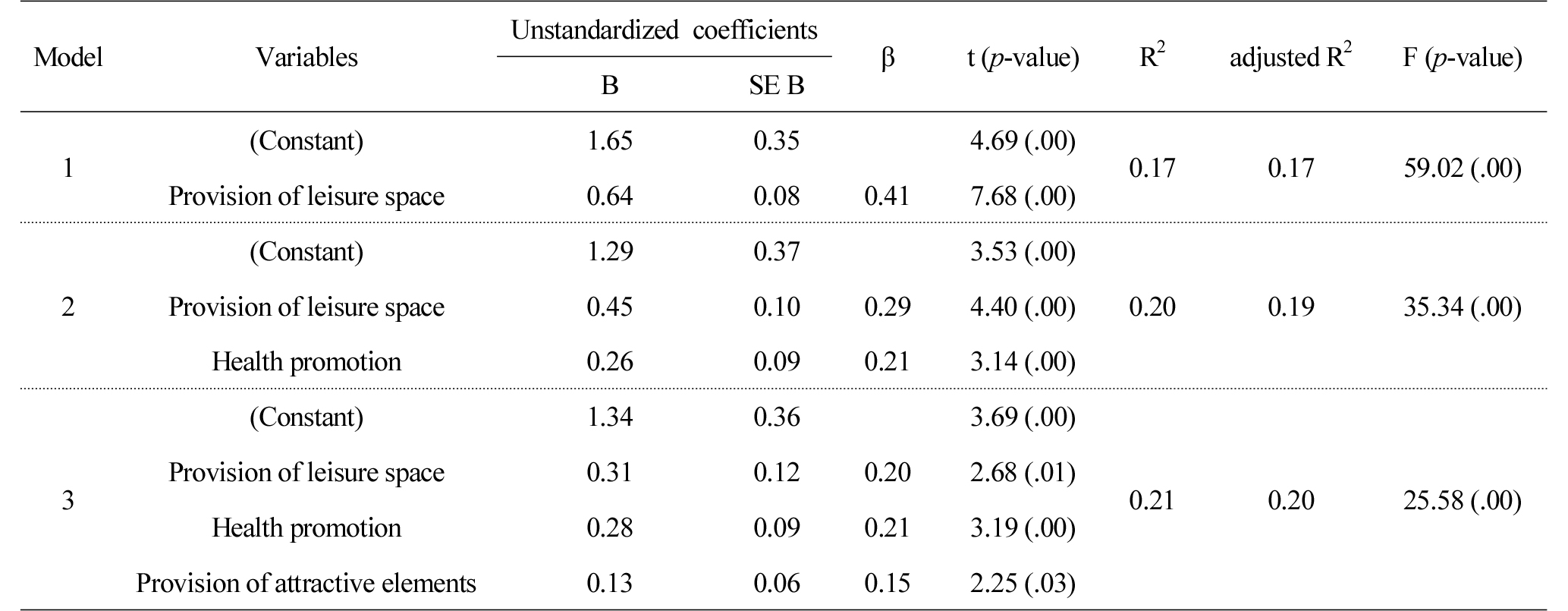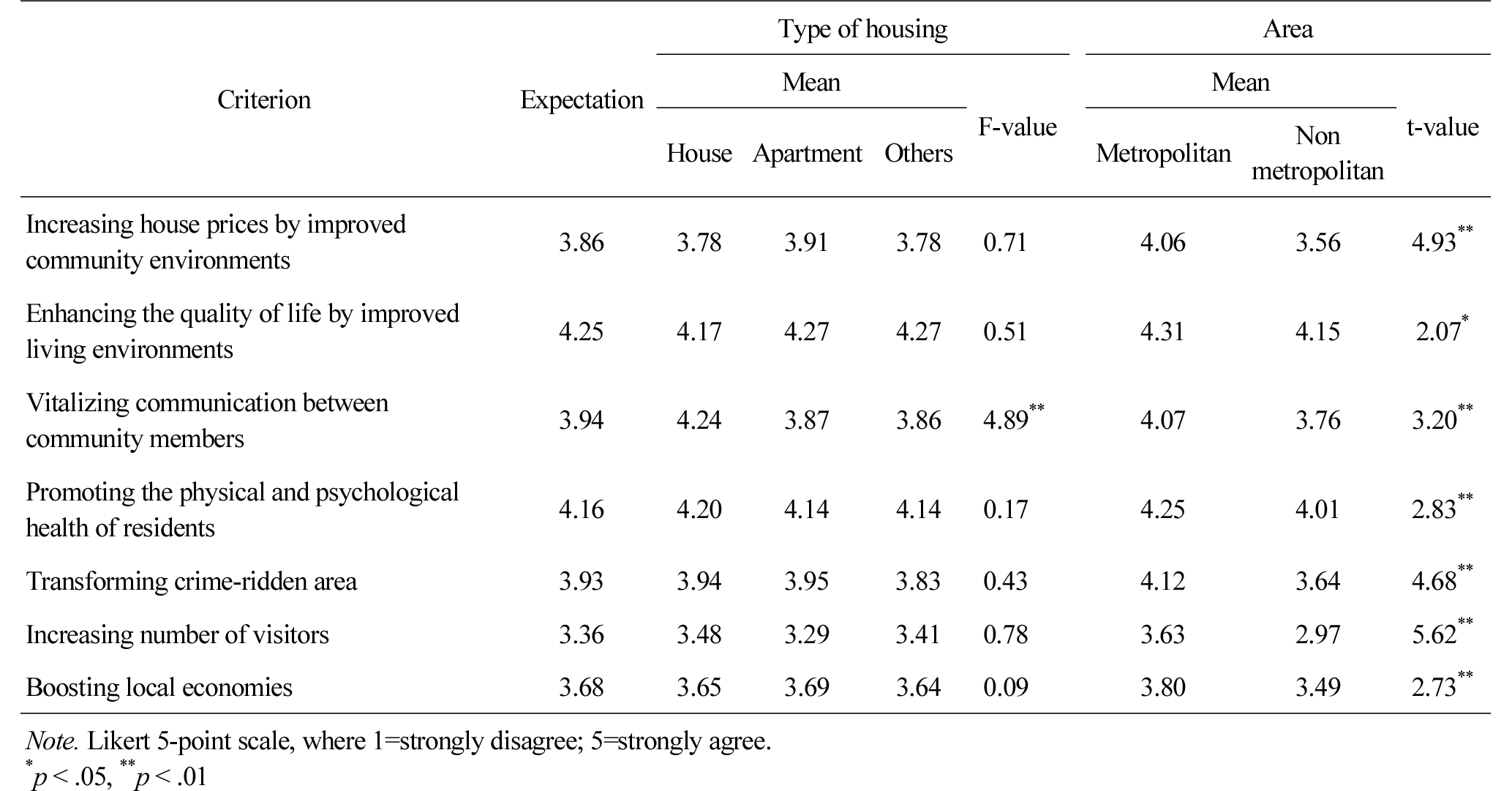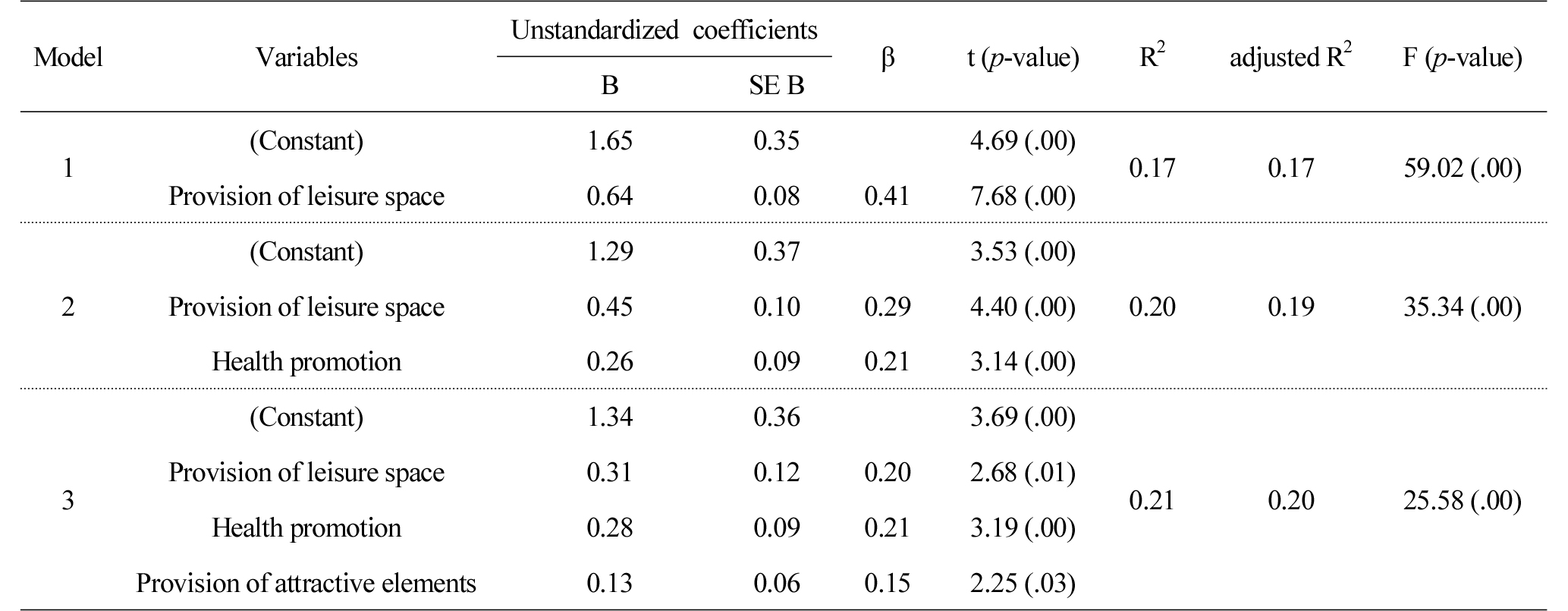Functionality Importance and Expectation Analysis for the Planning Direction Establishment of Community Gardens
Article information
Abstract
This study aimed to investigate the perception of community gardens by urban citizens, who are the potential end-users and to establish baseline data to be used in the planning of community gardens. The study was conducted by surveying 200 people living in metropolitan area and 140 people living in non-metropolitan area from October 7 to October 10, 2016. The surveyed urban residents agree that community gardens are necessary, although there is a slight difference in their perception depending on the type of housing and residential area. More specifically, residents who have seen gardens and those that have experience in gardening strongly support for the need of community gardens. Community gardens should primarily satisfy both comfort and aesthetic functions. The surveyed residents focused on the function of the garden to improve personal satisfaction and quality of life. In addition, they expect personal benefits such as physical and psychological health promotion; and public benefits such as increased amenity and community vitalization from the creation of community gardens. Residents were strongly willing to participate in the planning, construction and management of community gardens. Therefore, community gardens should be designed to improve the living environments, prevent crime, provide leisurely space, promote physical and mental health, and provide visual pleasure. These will effectively improve the quality of life of urban residents and contribute to the revitalization of the community.
Introduction
As industrialization and urbanization have progressed, emotional exchanges that had long been cherished have been destroyed, causing various problems. In addition, in the fourth industrial revolution represented by artificial intelligence and the Internet of Things (IoT), human alienation, damage to dignity and polarization of wealth are expected to continue to cause social problems. In order to prevent and manage conflicts in an effective and fundamental way, it is necessary to improve trust in our society, and the recovery and reconstruction of communities are integral elements in improving social trust. For the healthy development of society, community values and lifestyles that value solidarity and cooperation are inevitably highlighted, rather than segmented and fragmented individualism, and the establishment of local communities based on solidarity and cooperation has become one of the challenges of the times (Chae, 2014). A community is a group of people who share a certain style of living and have a strong sense of bond and solidarity with other members, having a certain geographical boundary (Shim, 2016). Jeon et al. (2012) explained that a community is a group or cluster formed based on a sense of belonging and bond within a geographical boundary, sharing similar ideas. It is also defined as a social group of which members share a common lifestyle between members within a certain area and interact with a sense of closeness and solidarity (Bang, 2015). There are some differences in the definition of community between researchers, but it can be explained basically with geographical boundaries, social interactions, and value systems (norms) shared between community members.
As the necessity of vitalizing communication between generations and local communities increases, community gardens have been suggested as an alternative. In order to build a sense of attachment and belonging to a community between local residents, they need to share a certain space and maintain a continuous relationship through active exchanges based on locality, social relationship and a sense of bond. In this regard, community gardens can be utilized as a place for local residents to gather and share (Shin et al., 2010). Their value has been highlighted again as a place through which various types of people share green spaces and engage in and restore local communities. The benefits of community gardens have been noticed in the United Kingdom, Germany and the United States, and they can be created by utilizing areas left or abandoned within communities, which can contribute to improving the landscape, reducing the number of crimes and providing opportunities for social participation for those who can be easily alienated from society such as the elderly and the weak. In addition, it has been reported that community gardens can be utilized as a place for education for children and the youth, and also have various effects such as increasing regional economic values and accelerating the participation of residents in local activities (Hynes and Howe, 2004; Saldivar-Tanaka and Krasny, 2004; Maller et al., 2006; Alaimo et al., 2008; Litt et al., 2011; Zick et al., 2013; ArtMcCabe, 2014). Taking advantage of these benefits, community gardens such as shared vegetable gardens and shared gardens have also been created in Korea by utilizing abandoned lands, but they have not been continuously operated and maintained, but abandoned.
There are studies on the spatial, social and psychological effects of village gardens, and community gardens (Kim and Cho, 2010; Rho, 2012; Kim, 2013; Kim and Lee, 2013), the development and planning of community garden models (Kim, 2011; Oh and Park, 2015; Choi and Seo, 2016), and the creation of gardens as a strategy for vitalizing communities (Kang et al., 2013; Han and Nam, 2015). Most earlier studies assessed local residents’ satisfaction with created community and village gardens, but directions for creating community gardens amid a growing demand have not been researched much.
Therefore, this study aimed to conduct a survey on the awareness of urban dwellers, who are potential sources of demand and will participate in the creation and maintenance of community gardens, on community gardens and to provide basic data for determining directions for community gardens.
Methods
Composition of questionnaire
Before setting directions for the creation of community gardens, questions were developed based on earlier studies on the necessity of community gardens, functionality importance, expected effects and engagement (Kim, 2011; Roh, 2012; Kim and Lee, 2013; Jeong et al., 2017). In order to assess the importance of the functions of community gardens, 11 questions were developed. A preliminary survey was carried out to improve the reliability of this survey and review the internal consistency of the questions, and Cronbach’s alpha was 0.859, showing a significant reliability. On the expected effects of creating community gardens, 7 questions were developed, and their Cronbach’s alpha was 0.822, showing a high internal consistency. In addition, engagement in creating community gardens was surveyed by dividing it into the stages of planning, construction and maintenance (Table 1).
Subjects and survey methods
A questionnaire survey on community gardens was performed on urban dwellers who live in areas where projects to improve communities or physical environments, such as projects to create villages or urban restoration projects are not currently executed, in order to control the influence of experiences on community gardens. The questionnaire survey was carried out on two groups of urban dwellers (200 people living in the metropolitan area and 140 people living in the non-metropolitan area) from October 7 to 10, 2016. The developed questionnaire was distributed and the respondents filled out the questionnaire. Answer sheets of those who insufficiently filled out were excluded, and thus an a total of 320 answer sheets (192 in the metropolitan area, 128 in the non-metropolitan area) were analyzed.
Analysis methods
The collected data were analyzed using a statistical program, SPSS 20.0. A descriptive statistical analysis was performed on the questions about the necessity of community gardens, functionality importance, expected effects and engagement. The t-test and ANOVA (Analysis of Variance) were carried out to analyze differences depending on the types of housing (detached house, apartment house, others: studio apartment, multi-family house), and the types of living areas (metropolitan and non-metropolitan). In addition, correlations between functionality importance and expected effects were reviewed by analyzing correlations between questions and performing importance-performance analysis (IPA). IPA is an assessment technique that has a conceptual structure with a multi-attribute model, and subjects are instructed to set and assess directions for importance and performance on their own in order to compare and analyze attributes (Yun, 2013). In this study, directions for creating community gardens were divided into importance and expectation, and regression analysis was performed to identify functions that affect the necessity of community gardens.
Results and Discussion
Necessity of community gardens
The necessity of community gardens was assessed using Likert 5-point scale, and the score of the necessity of community gardens was 4.35 points, which indicates that subjects thought that community gardens were highly necessary. In terms of the types of housing, the necessity of community gardens for detached houses was the highest, followed by others and apartment houses, which indicates that the demand for community gardens from detached houses was higher than that from apartment houses (Table 2). It was also found that urban dwellers living in the metropolitan area recognized the necessity more highly than those living in the non-metropolitan area, showing a statistically significant difference. Since there are many chances for people living in the metropolitan area to experience or participate in garden activities through various garden-related cultural events, such as “Seoul Garden Show” and “Gyeonggi Garden Culture Expo” and through gardening projects such as “Seoul In Blossom”. Therefore, subjects in the metropolitan area seemed to highly recognize the importance of gardens as a space for daily life or activities. The importance of community gardens depending on the types of housing and living areas was analyzed, and chances to experience gardens and gardening were found to contribute to raising the awareness of the importance of community gardens.
Directions for creating community gardens
Functions of community gardens
The functionality importance of community gardens was assessed using Likert 5-point scale. The score of securing green spaces within urban areas was the highest (4.34), followed by providing spaces for comfortable resting (4.33), give children an opportunity for ecological experiences (4.33) and improving the cleanliness and landscape of villages (4.32). These results indicate that subjects highly recognized the functions of community gardens from the aspects of comfortability and aesthetic values. The score of providing psychological stability, providing chances to enjoy the beauty of plants, providing spaces for health promotion, providing spaces for hobby and providing spaces for communication with neighbors was 4.29, 4.20, 4.15, 4.12 and 4.03 respectively, showing a high functionality importance of promoting physical and psychological health and communities for local residents. The score of providing spaces for the production of safe food and providing charming elements that can attract people was relatively low (3.65 and 3.83 respectively), showing a low functionality importance of producing things of which ownership is induced in public spaces and attracting people. Earlier studies also pointed out that community gardens are expected to provide local residents with easy access to gardens for relaxation and to function as a life-friendly public space (Table 3). From a behavioral perspective, the demand for comfortability such as relaxation and emotional stability is higher than that for production activities in vegetable gardens (Jeong et al., 2017).
Urban dwellers living in detached houses and apartment houses showed relative differences in terms of priority although there was no big difference in the average score of the functions of community gardens. The function of providing children with chances for ecological experiences ranked first among those living in detached houses, but ranked fifth among those living in apartment houses, showing a relatively low importance. However, those living in apartment houses highly prioritized the functions of providing psychological stability and securing green spaces within urban areas, while they were less prioritized among those living in detached houses. Those living in detached houses recognized the importance of providing children with chances for ecological experiences relatively highly, while those living in apartment houses recognized the importance of comfortability such as providing green spaces and securing psychological stability highly.
The overall score of the functionality importance of urban dwellers living in the metropolitan area was higher than that of those living in the non-metropolitan area, and in particular, the score of functions such as providing spaces for hobby, health promotion, producing safe food, enjoying the beauty of plants and providing charming elements that can attract people was statistically significantly high. The results indicate that community gardens need to provide social and psychological functions such as providing psychological stability and providing spaces for communication with neighbors, and environmental functions such as securing green spaces within urban areas, and improving the landscape of villages. There was a difference in priority between the metropolitan and non-metropolitan areas. Those living in the metropolitan area valued the educational functions such as providing chances for ecological experiences most highly, while those living in the non-metropolitan area prioritized the function of providing comfortable spaces for relaxation highly.
Expected effects of community gardens
The expected effects of the creation of community gardens were assessed using Likert 5-point scale. Those such as enhancing the quality of life by improved living environments and promoting the physical and psychological health of residents showed a high score (4.25 and 4.16 respectively), followed by vitalizing communication between community members (3.94), transforming crime-ridden areas (3.93), increasing house prices by improved community environments (3.86), and boosting local economies (3.68). First of all, the score of those for comfortability and health promotion was the highest, followed by those for publicness such as forming the spirit of community and increasing safety. Whereas, the score of increasing the number of visitors by providing more attractions and invigorating local economies was low. Unlike people in general expect that local economies can be invigorated through community gardens, local residents seem to think that community gardens can be utilized as a space for actual residents to enjoy (Table 4). These results are similar to those of an earlier study (Jeong et al., 2017) that the expected effects of community gardens are affected by comfortability and landscape ecology.
There was a statistically significant difference in some expected effects, such as facilitating communication and friendship between community members, between the subjects living in detached houses and apartment houses. Those living in detached houses had a higher expectation for expected effects such as facilitating communication and friendship between community members than those in the other groups, and those living in apartment houses had a high expectation for improving the quality of life. As other studies showed, the desire of those living in apartment houses for personal satisfaction, rather than the spirit of community, is high, while the expectation of those living in detached houses for improving the spirit of community is relatively high.
There were statistically significant differences in all the criteria between the groups, and the overall score of the expectation of those living in the metropolitan area was high. The order of priorities in each criterion was similar. Expected effects that show a little difference depending on the types of housing such as improving living environments and promoting health were the highest. In other words, the usage rate of community gardens can be increased only when demands for improving the quality of life or promoting personal benefits are met.
Directions for creating community gardens based on IPA
Importance-performance analysis (IPA) is a technique used to measure importance and satisfaction that users recognize and analyze current state, but in this study, importance-expectation analysis was carried out in order to locate items on a matrix and predict the direction of development. The functions and expected effects of community gardens were categorized into criteria including improvement of living environments, health promotion, community vitalization, increasing in visitor numbers, improvement of cleanliness and crime prevention in this study (Table 5).
Expectations for improving living environments, promoting health, vitalizing communities, improving cleanliness and preventing crimes were relatively high, but that for attracting tourists was low. The importance of functions such as preventing crimes and improving living environments was high, but that of functions such as promoting health, vitalizing communities and increasing the number of tourists was low. Subjects seemed to highly recognize the importance of the function of improving or enhancing the quality of life (Fig. 1).
Functions and expectations including improving living environments, improving cleanliness and preventing crimes fell in the first quadrant that indicates a high importance and expectation, and thus it is necessary to set directions for creating community gardens to ensure these functions and expectations can be met. The fourth quadrant indicates that subjects do not recognize importance but have a high expectation, and promoting health and vitalizing communities fell in the fourth quadrant. Subjects seemed to focus on the characteristics of gardens rather than social aspects in terms of functionality, while they seemed to have high expectations for the outcomes of creating community gardens. In other words, they approached the functions of community gardens as a space for common use, while they approached the expected effects of community gardens from an perspective of benefits from the existence and use of gardens. Since both the importance and expected effect of attracting tourists that fell in the third quadrant was low, it does not need to be considered in creating community gardens. In the early years of creating community gardens, their visual aspects were highlighted in order to invigorate local economies by attracting tourists, but from a perspective of local residents who are the actual users of community gardens, the demand for improving the overall quality of life is higher than that for attracting people.
Directions for creating community gardens based on necessity
The functions of community gardens were categorized into hobby and leisure activities, exchanges with neighbors, health promotion, education, food production, improving the landscape and environment, and providing attractions, and regression analysis was performed on the effects of the functions on the necessity of community gardens. Each model’s R2 value was not high and showed a weak descriptive power, but their statistical trends were interpreted in this study (Table 6). The function that had the most statistically significant effect on the necessity of community gardens was hobby and leisure activities, followed by health promotion, and providing attractions. As the overall results of the analysis show, people seemed to expect that community gardens would contribute to facilitating exchanges and communication with neighbors and vitalizing communities as a public space, but the actual use behaviors were found to prioritize personal benefits.
Participation and engagement in community gardens
The engagement of subjects in creating and operating community gardens was assessed using Likert 5-point scale The score of engaging in the process of planning, construction and maintenance was 4.01, 3.95 and 3.81 respectively, indicating that they want to participate more in the early stage of creating community gardens. In order to ensure gardens continue to function well, it is very important to maintain them, but urban dwellers still did not show an active attitude toward the maintenance of gardens (Table 7). The low participation level can be attributed to the fact that maintenance requires the continuous participation of people and did not show visible outcomes in a short period of time. In addition, people tend to think that the maintenance of gardens requires special knowledge or skills, which seemed to result in the low participation level in maintaining community gardens.
Urban dwellers living in detached houses were most strongly willing to participate in all the processes of creating community gardens including planning, construction and maintenance, while those living in studio apartments or multi-family houses showed a relatively high participation level in the process of construction, Overall, the level of engagement in planning was the highest, followed by construction and maintenance. In addition, the engagement level of those living in the metropolitan area was higher than those living in the non-metropolitan area, showing a statistically significant difference. The overall engagement level of those living in the non-metropolitan area was slightly higher than the average, but their level of engagement in maintenance was the lowest.
Conclusions
This study was conducted to survey the awareness of urban dwellers on community gardens and to provide basic data for determining directions for community gardens. The results of this study indicated that urban dwellers recognized the necessity of community gardens highly, and that experiences of gardens or gardening affected the positive effects of gardens. They were also found to recognize the importance of the comfortability and aesthetic values of community gardens the most, followed by the promotion of psychological and physical health and communities for local residents. Community gardens need to have social and psychological functions such as providing psychological stability and facilitating exchanges with neighbors as well as environmental functions such as improving the landscape and securing green spaces. They expected that community gardens would improve comfortability and health, form the spirit of community and increase safety. Unlike community gardens focus on improving the spirit of community by combining communities and gardens, local residents who are the actual users of community gardens focus on their functions as a space to enjoy such as improving personal satisfaction and the quality of life. In addition, urban dwellers are strongly willing to participate in the creation and operation of community gardens. Considering the importance and expected effects of community gardens comprehensively, community gardens are approached from the perspective of public space in terms of functionality, while they are approached from the perspective of benefits in terms of expected effects. First of all, it is necessary to set directions that can fulfill their needs for improving living environments and preventing crimes. They also need to promote health and exchanges between residents, but it is not necessary to consider ways to attract tourists in creating community gardens. In particular, community gardens that are created in the metropolitan area need to provide places for hobby and leisure activities in order to secure functions such as promoting physical and psychological health and satisfying visual needs.
Community gardens with different functions and forms can be created as a public space for local residents depending on the characteristics of areas and the composition of residents, but general directions for creating community gardens were suggested in this study. It will be necessary to further research directions based on the locational characteristics and purposes of creating community gardens.














